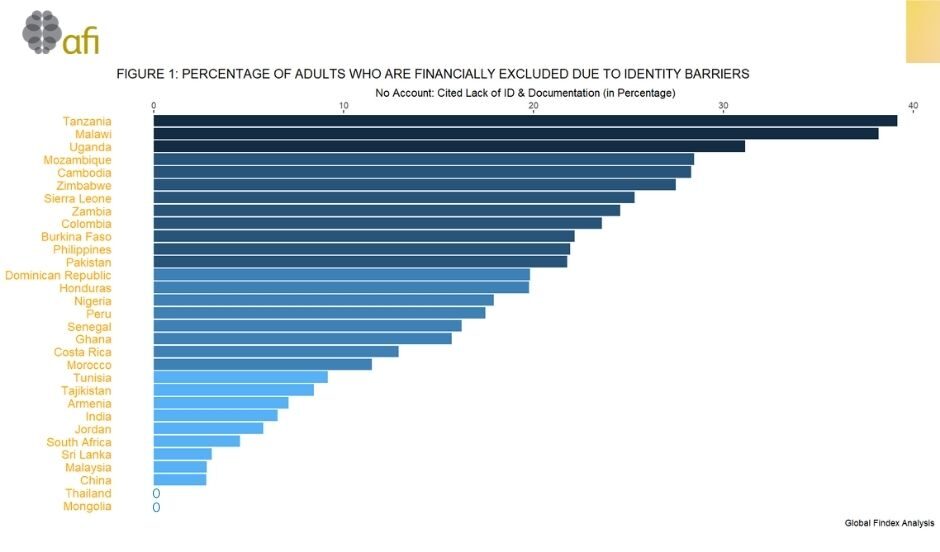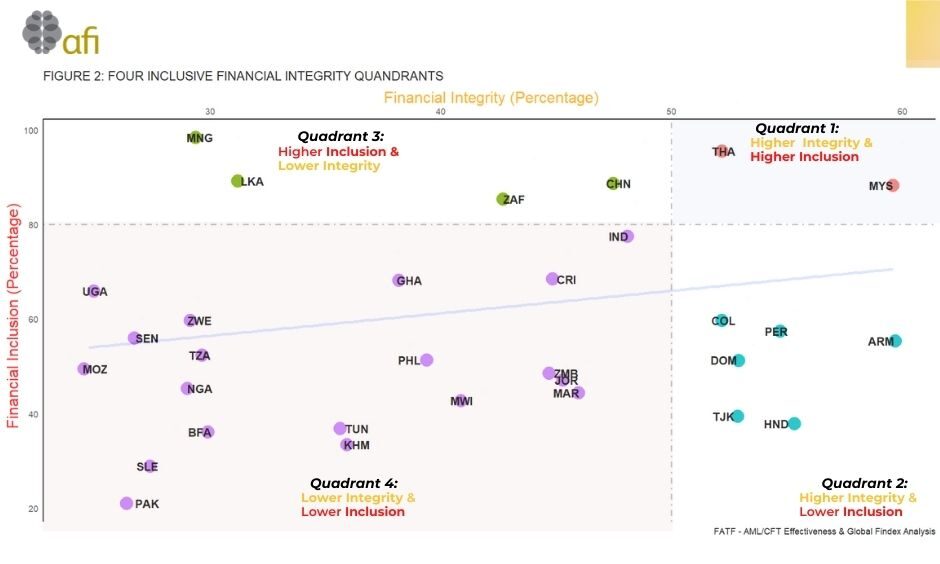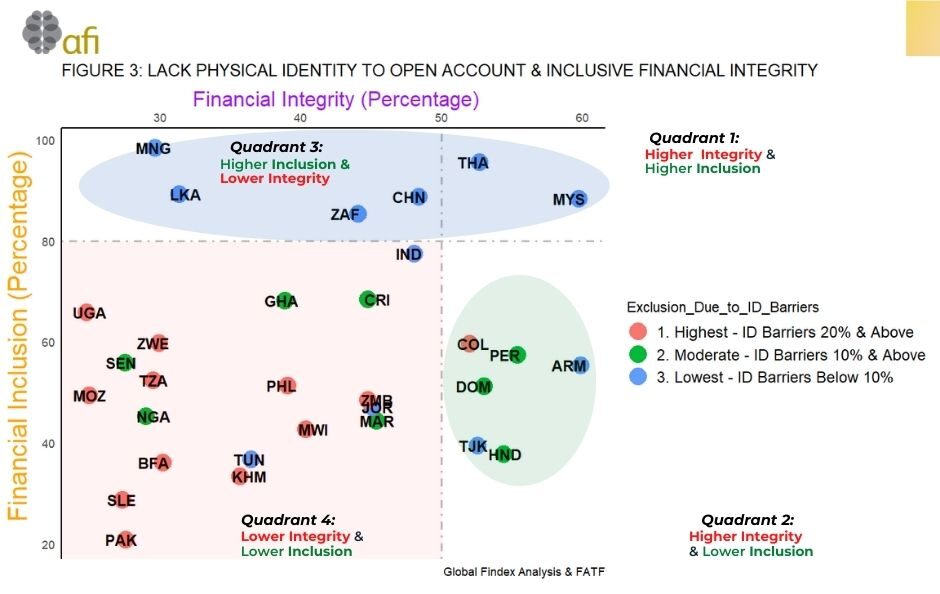By Robin Newnham, Head of Policy Analysis & Guidance, AFI and Kolawole Adegoke, MBA candidate, Asia School of Business[1]
The recently released 2021 Global Findex has provided a fillip for financial inclusion policymakers, with many countries recording substantial growth in bank and mobile money account ownership. The global gender gap in financial access has also reduced for the first time. Such progress is truly encouraging, yet despite this momentum 1.4 billion adults remain excluded from formal financial services, and the outlook for financial inclusion remains uncertain amidst the spectre of spiralling inflation, hitting those on low incomes the hardest, and a potential global recession.
One of the significant barriers to greater inclusion remains challenges those outside of the formal financial system face to meet ID and documentation requirements for account opening. To comply with the global anti-money laundering, countering the financing of terrorism, and countering proliferation financing (AML-CFT-CPF) standards of the Financial Action Task Force (FATF), all financial service providers are required to verify the identity of their customers, with a risk-based approach encouraged for countries and individual financial services providers to determine which types of documentation should be provided for this purpose.
Countries that have successfully and systematically implemented the risk-based approach, for example through the use of simplified due diligence in cases of assessed lower AML-CFT-CPF risk, are making progress towards the vision of inclusive financial integrity, defined elsewhere by AFI as “the successful alignment of complementary financial inclusion policy goals with effective AML-CFT objectives by bringing financial transactions into the formal financial sector where they can be monitored”.[2]
Findex 2021 shows, however, that ID requirements remain a significant barrier to account opening in a significant number of developing countries, with insufficient ID documentation cited as barrier to account opening by more than 20% of those without an account in 12 countries.

Analysing the relationship between financial inclusion and financial integrity
In order to assess the relationship between financial inclusion and financial integrity in light of the new Findex data, we calculated a financial integrity score for each country in the AFI network for which there is Findex data. The score is based on each country’s ratings for AML-CFT effectiveness according to its last assessment by FATF or respective FATF-style regional body (FSRB).[3] These financial integrity scores were then juxtaposed with the Findex data for account ownership, as an indicator of financial inclusion levels.

The results highlight a positive association between financial inclusion and financial integrity outcomes. Countries with higher levels of financial inclusion tend to be also rated higher for financial integrity, and vice-versa. The positive correlation between financial inclusion and financial integrity outcomes reinforces the understanding that inclusion and integrity are complementary goals that should be pursued in tandem. Indeed, two countries in the analysis (quadrant 1) score particularly highly on both financial inclusion and financial integrity, demonstrating that progress in both areas can be aligned without necessarily involving trade-offs.
It is also noteworthy that 6 countries (quadrant 2) in the analysis have achieved high AML-CFT effectiveness, yet with significant proportions of their population (40-60%) remaining outside of the formal financial system. Conversely four countries (quadrant 3) in the analysis had achieved high rates of financial inclusion but, according to their latest Mutual Evaluation assessments, have identified need to improve their AML-CFT effectiveness. Meanwhile, the majority of countries examined (19 countries in the analysis, quadrant 4) have scope for enhancement on both financial inclusion and financial integrity metrics.
Looking through the lens of physical identity barriers
Next, we introduced the dimension of lack of identity documentation (figure 1 above), as a barrier to account opening to assess the relationship of this measure to overall account ownership and financial integrity data.

Introducing this data set from Findex highlights that countries, where ID documentation remains a challenge to open a bank or mobile money account, are found disproportionately at the lower end of the spectrum for both financial inclusion and financial integrity measures. In contrast, ID is not a significant barrier for any country with account ownership over 80%.
This finding suggests that where identity verification requirements remain a significant barrier to account opening, this factor is likely to be significant drag on a country’s overall financial inclusion rate. Interestingly however, high incidence of ID challenges as a barrier to account opening also appears to be associated with lower financial integrity scores, (though the relationship is not quite as pronounced), suggesting that persistent ID barriers may be symptomatic of broader challenges in the application of the risk-based approach to AML-CFT. Since financial exclusion has itself been acknowledged as an AML-CFT risk, the persistence of overly stringent documentation requirements may also constitute a risk to financial integrity by keeping financial exclusion rates higher.
Achieving Inclusion Financial Integrity: Lesson Learnt from Malaysia and Thailand
Two countries in AFI network – Malaysia and Thailand – stand out from the analysis as achieving notably high scores for both financial inclusion and financial integrity metrics, according to the global Findex and FATF assessment data respectively. Notably, both countries have prioritized digital transformation within their financial inclusion and their AML-CFT strategies and have implemented electronic KYC (e-KYC) policies. Where implemented with both inclusion and integrity goals in mind, the emerging implementation experience suggests that digital identities and e-KYC can contribute both to increased access to financial services, and also to more robust and focussed AML-CFT regimes.
Policy Implications of the analysis
Based on the analysis above, some policy suggestions can be considered based on which quadrant of the inclusive financial integrity matrix countries find themselves:
- Quadrant 1: Countries – such as Malaysia and Thailand – scoring highly on both financial inclusion and financial integrity metrics, demonstrate the complementarity of inclusion and integrity goals and provide valuable case studies for peers to learn from as they implement their own roadmaps to achieving both policy goals;
- Quadrant 2: Countries assessed as already having high levels of AML-CFT effectiveness, but with lower levels of financial inclusion, may consider whether they can build a greater degree of proportionality into their AML-CFT regime in order to contribute positively to financial inclusion outcomes, and particularly the elimination of ID documentation barriers to financial inclusion;
- Quadrant 3: Countries that have achieved high levels of financial inclusion, but with assessed lower levels of AML-CFT effectiveness, should consider how to address their AML-CFT vulnerabilities in line with assessors’ recommendations, but should be careful to ensure that doing so does not compromise or risk any reversal of the financial inclusion gains they have achieved;
- Quadrant 4: Countries in the lower part of the spectrum for both financial inclusion and financial integrity will need to address challenges faced in both policy areas. As they do so, experience suggests both objectives will benefit through aligning interventions under a shared national-level vision for achieving Inclusive Financial Integrity.
[1] The authors are grateful to Professor Ozer Karagedikli (Director of Central Banking Research Center, Asia School of Business), Professor Louis de Koker (Professor of Law, La Trobe University), and Mariam Zahari (Policy Specialist, AFI) for their review and valuable comments.
[2] Four policies to promote inclusive financial integrity in 2021 | Alliance for Financial Inclusion (afi-global.org)
[3] The Financial Integrity score was derived from taking an average of the assessment ratings for the 11 Immediate Outcomes for AML-CFT effectiveness. For more detail on the FATF methodology for assessing AML-CFT effectiveness, see Documents – Financial Action Task Force (FATF) (fatf-gafi.org)

 About
About
 Online
Online
 Data
Data





















